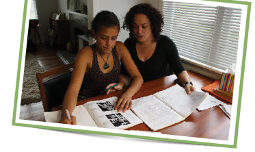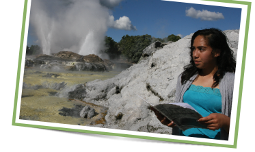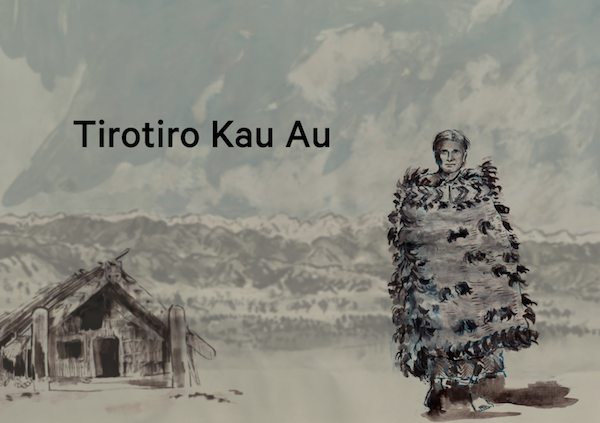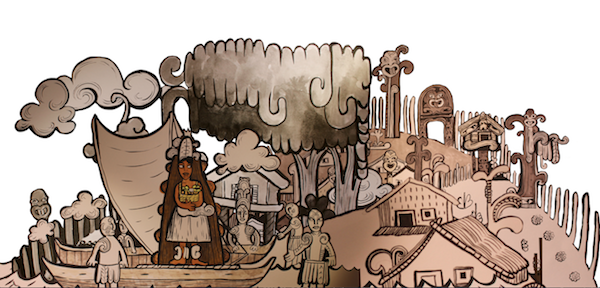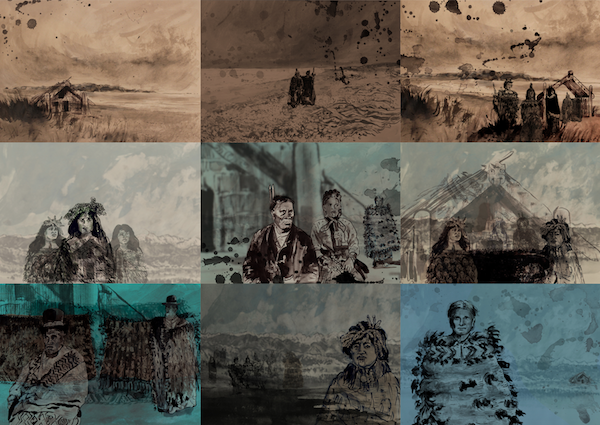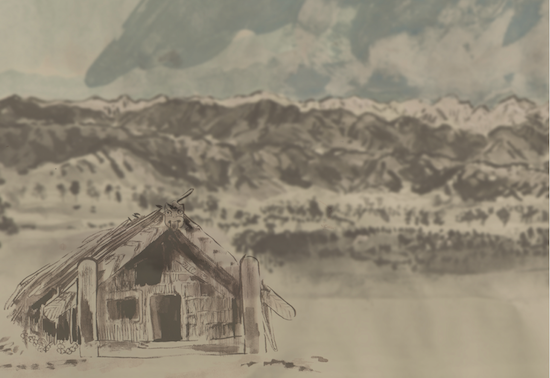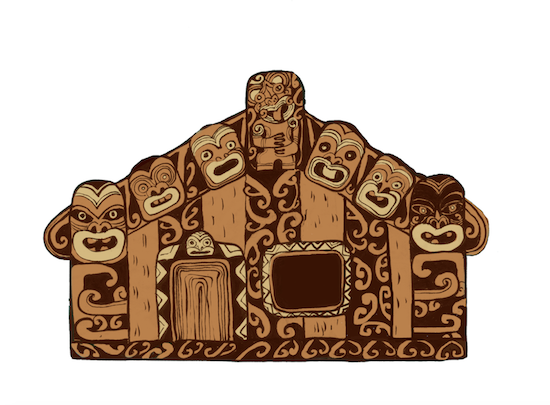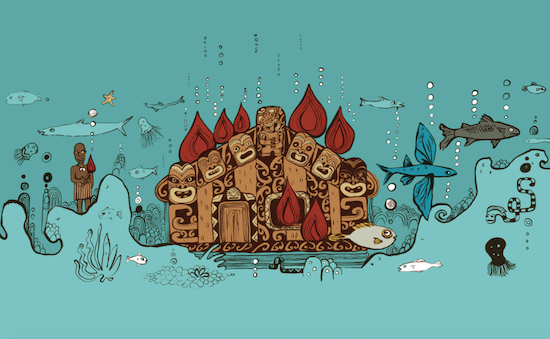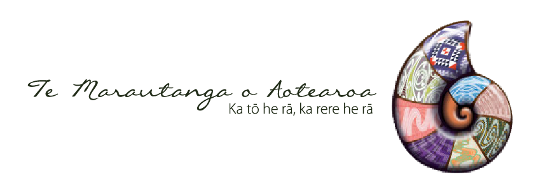Tirotiro Kau Au: Level 2–3
Te Marae me Tōna Reo
At its centre, this unit of work utilizes the Kararaina Anaru’s waiata tangi, Tirotiro Kau Au. The unit includes activities that link to the Reo Māori, Tikanga ā-Iwi, and Ngā Toi learning areas, supporting teaching and learning at levels 2–3 of Te Marautanga o Aotearoa. The activities focus on pepeha and maunga.
The unit is thematic in design, but focuses particularly on creating oral language opportunities – both formal and informal.
Tirotiro Kau Au
Nā Kararaina Anaru i tito
Tirotiro kau au ki marae kāinga, e rā
Kei whea koutou e ngaro nei e te iwi, e rā
Taku aroha ki ngā tai e ngunguru, e rā
E rite mai ki te iwi, e ngunguru noa nei, e rā
Takoto mai i runga i te atamira, e rā
Ka tōkia tō kiri e te anu mātao, e rā.
Akoranga 1
Whakarongo
Purpose
To introduce, listen to, and discuss the waiata tangi Tirotiro Kau Au with students.
Learning Intentions
The students are learning:
- To listen to the waiata tangi Tirotiro Kau Au.
- To identify some key words in Tirotiro Kau Au.
- To share their thoughts and feelings about Tirotiro Kau Au.
- To perform the waiata tangi Tirotiro Kau Au.
What You Need
- Tirotiro Kau Au – animated mōteatea and the audio file
- Data projector or interactive whiteboard
- Cushions or pillows (optional)
- Building blocks, lego, other building resources
- Images – TANGI-A1.PDF, KĀKAHU-A1.PDF, KARARAINA-A1.PDF, KŌTIRO-A1.PDF, MANUHIRI-A1.PDF, MARAE-TAI.PDF, TĀNE-TAI.PDF, TĀNGATA WHENUA-A1.PDF, TANGI-A1.PDF, WĀHINE-A1.PDF
What You Do
Akoranga ā-Akomanga.
(Suggestion – teach first thing in the morning, over a number of sessions.)
- Ask your students to find a space where they are comfortable and close their eyes. (They could lie down). Play the audio track Tirotiro Kau Au and listen to the entire waiata.
Ngāti Ruakawa recording - Tirotiro Kau Au
- After listening ask these questions:
What feelings did you get when you listened to this mōteatea?
Did anything happen to you when you were listening?
Explain:
Tirotiro Kau Au is a waiata tangi, composed by Kararaina Anaru, of Ngāti Pareraukawa. Waiata tangi sound sad because they express sad feelings. You will hear them at tangi, and other occasions when people come together at the marae and remember those people who have gone before. The language that Kararaina Anaru uses in Tirotiro Kau Au creates images that seem desolate and sad.
Design a poster
Organise students into pairs or small groups and get them to make a list of images and another of words that evoked sadness.
Possible list:
– The picture of the marae on its own, (with no people).
– The kuia standing on her own.
– The landscape around the marae being empty.
– Old people in old times.
– The weather looking dark and gloomy.
– When the people arrive for the tangi.
– The whānau pani on the mahau.
Possible words:
– Kei whea koutou e ngaro nei, e te iwi?
– Taku aroha
– Ka tokia tō kiri i te anu mātao
- Each pair (or group) chooses one of the following images and uses one line from the waiata as a starter, for a descriptive paragraph about the image. (Download and use these A3 sized images – add text with the computer or by hand.)
E.g. Tirotiro kau au ki marae kāinga. He marae mokemoke tōku marae. E tū ana ahau i raro i te pae maunga mō te hokinga mai o te iwi.
Groups make an A3 poster using the text and image.
Gallery walk – conversations
This is a small group activity, and encourages students to respond to the posters (images and texts) they have created.
- Display the posters around the walls of the classroom – at “stations”.
- Groups visit each station and are given a short presentation about the poster. Organise the groups so there is a ‘guide’ in each group for each of the ‘stations’ i.e. a person who was involved with producing the poster.
- Students respond to the presentation, adding their own thoughts and feelings about the poster.
- As a class brainstorm marae and make a list of all the things that make a marae as we know it – a living marae.
Build a marae
Possible list:
– Tupuna whare
– Whare kai
– Marae atea
– Kaumatua
– Tāngata
– Tamariki
– Puna reo
– Kura
– A place for the whānau to come together
– A place to host visitors.
- Organise students into groups of 3 or 4.
- Each group has a set of lego, wooden blocks or other model making equipment. They are to build a marae complex and include all the things they think go to making a living marae. They also need to think of a name for their marae – and a reason for the name.
Encourage them to work cooperatively to plan and build their marae. You could give them a time limit.
- When the marae are complete each group presents their marae to the rest of the class:
– The name (and reason for its name).
– A description of the steps they took to build the marae.
– The different areas they created and an explanation of why they chose to build them.
- Groups respond to each other’s presentations.
- Record results by taking a photograph. These can be printed out and displayed or put in student portfolios.
Learn Tirotiro Kau Au
- The next task is to learn Tirotiro Kau Au. Use these to help with teaching and learning:
– Replay the audio or audio visual recording of Tirotiro Kau Au to your students.
– This link to recordings of Ngāti Raukawa tribal waiata (6. Tirotiro Kau Au).
https://www.youtube.com/watch?v=IXiTCeKhT4c
– Read Tirotiro Kau Au with your students.
Ako ā-Kākā
- A whole class activity – learn all six lines of Tirotiro Kau Au. (N.B. The last two lines are only sung at tangihanga.)
- As a group recite the lines. Learn line by line, adding a new line when you are confident that the group has embedded the previous lines.
- Practise the waiata regularly to embed the learning.
Possible Assessment Opportunities
- Students share their thoughts and feelings about the waiata tangi Tirotiro Kau Au.
- Students listen to the waiata tangi Tirotiro Kau Au.
- Students contribute ideas about what makes a living marae.
- In small groups, students discuss, plan and build a model of a marae complex.
- Students present their marae to the wider class group.
- Students respond to presentations.
- Students learn and practise the waiata tangi Tirotiro Kau Au.
Akoranga 2
Te Whare Whakairo
Purpose
To investigate the origins of whare whakairo.
Learning Intentions
Students are learning:
- The story of Ruatepupuke and the Origins of Carving.
- To recall key ideas in the story.
- To work cooperatively to build a whare from newspaper and tape.
What You Need
- Internet connection
- A visit to a local marae, whare whakairo
- Images of carvings and whare whakairo
- Newspapers (start collecting as a class well before the lesson)
- Masking or packing tape
What You Do
Te Orokohanga mai o te Whakairo
Ruatepupuke had a son, Te Manuhauturuki, who was captured by Tangaroa, taken to the depths of the ocean and mounted on his whare as a tekoteko. Ruatepupuke was determined to get his son back, and in doing so brought the art of carving back to his people.
This is a link to the story of Ruatepupuke and his journey to free his son, told by Mohi Ruatapu and Hēnare Pōtae. (Also told below.)
In te reo Māori:
http://www.teara.govt.nz/mi/tangaroa/page-4
Or in English:
http://www.TeAra.govt.nz/en/tangaroa-the-sea/page-4
- Organise a trip to a whare whakairo to tell this story, or retell it in the classroom (see below).
- Take time to look at the carvings in the whare. Someone from the marae may be able to explain some of the carvings to your class. If you are in the classroom show images and examples of traditional wood carving to the students.
- Generate a class discussion to determine what students know already about the origins of carving, or about whare whakairo.
- Tell the story of Ruatepupuke and the origins of carving.
- Have an impromptu quiz to find out what the students have remembered about the story, using: Who? When? Where? What? And, How?
Ruatepupuke
Nā Mohi Ruatapu rāua ko Hēnare Pōtae o Ngāti Porou tēnei rerenga kōrero:
Ko ngā kōrero tēnei o Rua-te-pupuke nāna te whakairo i kite, te take i kitea ai he haerenga nō tana tamaiti, nō Te Manuhauturuki ki te whakatetere waka. Ka hopukia mai e Tangaroa taua tamaiti, ka kawea ki tōna kāinga ka meatia hei tekoteko nō runga i tōna whare. Nō te ngaromanga ka haere tōna matua ki te rapu…rokohanga atu e ia e noho ana tōna tamaiti i runga i te whare ...
Ka tae ia ki roto ki te whare e kōrero ana ngā poupou whakairo ki a rātou anō. Ka rongo ia e kōrero ana ngā poupou, ko ngā mea o waho i noho puku. Mahi ana hoki ia i taua whare … tō noa te rā ka tae mai a Tangaroa rātou ko tōna whānau, ka moe i roto i tō rātou whare. Kei te haka, kei te kū, kei te whai, kei te tākaro, tā te tini tāna mahi, whano tata ki te awatea ka moe. Kua ao te rā kei te pōuri anō te whare …
Kua tae a Rua-te-pupuke kei te roro o te whare e noho ana, me te toki i tōna ringa hei patu. Ka tahuna e ia te whare ki te ahi, ka rere mai ngā tāngata ki waho, a Kanae … I muri ko Maroro … I muri ko Kōkiri … Ko te nuinga o ngā tamariki a Tangaroa i patua … Ka tangohia e ia ngā poupou o waho o taua whare, nō ngā mea kāore e kōrero, nō reira i kore ai e kōrero ai te whakairi i nāia nei. [1]
Link to a picture of Ruatepupuke retrieving carvings from the Tangaroa’s house.
http://www.teara.govt.nz/en/artwork/7399/ruatepupuke
Build a house
- Organise the class into small groups and ask them to build a whare using just newspaper and masking tape – one that their group can all take shelter in when completed.
N.B. You will need plenty of newspaper – so begin collecting a few weeks earlier as a class.
- Make this a competition – they will self-assess and assess the work of the other groups. Explain the judging criteria:
– Teamwork – how well did they discuss the challenge? How well did they decide who does what? How well did they work together?
– Form – how effective is the construction method they choose?
– Function – how well does the ‘whare’ provide shelter for the group?
- You can impose limits depending on the skill level of the class:
– Limit the amount of newspaper and tape
– Set a time limit.
- When the whare have been completed, ask all the groups to sit inside their whare for judging.
Extension Activity
- Watch this 10-minute video (in English) about the Rongowhakaata Whare whakairo that is held at Te Papa Tongarewa in Wellington.
http://www.teara.govt.nz/en/interactive/45729/te-hau-ki-turanga-wharenui
- As a class, discuss some of the things that are spoken about in the documentary.
- Organise a class debate about the return of Te Hau ki Turanga to its people.
Possible Assessment Opportunities
- Students share what they know already about the origins of carving and whare whakairo.
- Students listen to the story of Ruatepupuke and the origins of carving.
- Students discuss ideas about building their whare.
- Students communicate (both speaking and listening) with each other during the whare building challenge.
- Students contribute their thoughts and feelings about the process and outcome of the whare building challenge.
- Students self-assess their whare building efforts based on these criteria:
– Teamwork
How well did they discuss the challenge? How well did they decide who does what? How well did they work together?
– Form
How effective is the construction method they choose?
– Function
How well does the whare provide shelter for the group?
Akoranga 3
Whakataukī
Purpose
To investigate the origins of whare whakairo.
Learning Intentions
Students are learning:
- Two whakataukī about Ruatepupuke.
- To write a story about an ancestor or atua of importance to them.
- To share their stories orally with their peers.
- To create an artwork that represents a tupuna or atua.
- Pens, pencils
- A4 paper
- Computers, tablets and printer (optional for publishing)
- A3 copies of WHAKAIRO 1-A3.PDF and WHAKAIRO 2-A3.PDF (carving template)
- Magazines
- Scissors
- Glue
- Crayons
- Dye (ochre coloured)
What You Need
What You Do
Ko ngā mahi whakairo. Ko ngā mahi a Rua.
Ngā kura huna a Ruatepupuke.
These are two well-known proverbs about Ruatepupuke. The first one credits Rua with the origin of carving. The second refers to the wealth of knowledge and wisdom hidden in the carvings themselves.
Although they are about Ruatepupuke and carving, the proverbs are often used when acknowledging beautiful artworks and the skill of the artist.
Use these whakatauki about art as inspiration for creating art and talking about it.
Ngā kura huna
Ngā kura huna a Ruatepupuke.
“The hidden treasures of Ruatepupuke.”
This whakataukī refers to all the wisdom, knowledge and skill that lies behind a carving. Only tohunga carve our whare whakairo, and the stories of the tribe are chiseled into the wood.
In our whare whakairo, important ancestors are immortalised in the carved posts that line the walls and tell the tribal stories that are important to remember.
- Share the whakataukī with the class.
-
Show your students an image of a carved post from a local whare whakairo (or from another another whare). Tell them the story of the ancestor and how the patterns, shapes and details tell this story.
N.B. Source a book about the opening of a whare as a resource. - Then get each student write a story about an ancestor of theirs or an atua that they know about and are inspired by. Ask them describe:
– Who is s/he?
– When did s/he live?
– What did s/he do?
– Why is s/he important to you?
- Once the students are happy with their drafts, they are to publish them on an A4 sheet and make a frame for it. (Their stories will be displayed alongside their artwork – next part of lesson).
- Students read their stories aloud to the class.
Ngā mahi a Rua
Ko ngā mahi whakairo. Ko ngā mahi a Rua.
Rua is the ancestor of the art of carving.
This whakataukī credits Ruatepupuke with the origin of the art of carving.
- Students are to ‘carve’ an ancestor or atua to display with the story they’ve just written.
- Provide magazines and scissors. Students cut out anything that is in their story – trees, birds, the sea, people doing certain things … anything connected to their story.
- Give each student a copy a carving template (WHAKAIRO 1-A3.PDF OR WHAKAIRO 2-A3.PDF).
- Students decorate the background with crayon and dye – drawing carving patterns and then washing the area with ochre coloured dye.
- Then get them to glue on the pieces they have cut out, as a collage, onto the carved shape. Encourage them to fill whole space so no white paper shows through. Explain that overlapping the cut–out pieces is okay. (You could Google ‘COLLAGE’ and display some of the image results.)
- When they have completed their ‘carved stories’ get them to share their stories in groups or as a class.
- Use the Art Appreciation approach in responding to each other’s. Here are some questions to help:
– What do you like most about Hana’s picture?
– What do you like most about your picture?
– How do the colours help to tell the story?
– How important are the patterns here?
– What did you like about these art techniques – crayon and dye, and collage?
Possible Assessment Opportunities
- Students read and listen to stories about significant tupuna or atua.
- Students present and respond to their own artwork and the artwork of their peers.
- Students can read their stories aloud to an audience.
- Students can give positive feedback to their peers using ‘Art Appreciation’ techniques.
Akoranga 4
Ngā Ika a Tangaroa
Purpose
To learn the story of Te Āhua o ngā Ika.
Learning Intentions
Students are learning:
- The story of Te Āhua o ngā Ika and why some fish look the way they do.
- Use their imaginations and create story about the features of a chosen fish.
- To speak confidently and share their ideas.
- The Internet, interactive whiteboard
- The story – TE ĀHUA O NGĀ IKA-A4.PDF
- Images of STINGRAY, HAMMERHEAD SHARK, LEATHERJACKET, SNAPPER, OCTOPUS, SWORDFISH, FLYING FISH and MULLET
- Sets of cards – NGĀ KĀRI-A4.PDF
What You Need
What You Do
Te āhua o ngā Ika
According to the story of Ruatepupuke, as the children of Tangaroa tried to escape the burning whare, Rua struck them with his toki as they came through the doorway.
– The stingray (whai) was hit on the nose leaving him with a pug nose.
– The octopus (wheke) was hit so hard that its backbone broke.
– The leather jacket (kōkiri) barely escaped the fire, and so has scorch marks all over its body
– The snapper (tāmure) came next and was badly burnt which is why the snapper’s scales are orangey-red.
– Rua struck a fish between the eyes and it became the hammerhead shark (mangōpare).
– He stuck his spear in another and it became the swordfish (haku).
– Only two fish escaped – the kanae (mullet) to the brackish water, and the maroro (flying fish) to the ocean.
Ika Ika
- Tell the story Te Āhua o ngā Ika. (Use TE ĀHUA O NGĀ IKA-A4.PDF.)
- Brainstorm fish and see how many different kinds of fish you can come up with as a class.
-
Show pictures of the fish that came out of Rua’s whare – Mangōpare, Haku, Whai, Maroro, Wheke, Tāmure, Maroro me te Kanae.
(Google: STINGRAY, HAMMERHEAD SHARK, LEATHERJACKET, SNAPPER, OCTOPUS, SWORDFISH, FLYING FISH and MULLET for images.)- Explain:
Our tūpuna told pūrākau to explain things that occur in nature – to make sense of the world around them. The story of Te Āhua o ngā Ika explains why some fish look the way they do.
- Organise the class into pairs. Students are to choose a fish from the list and search for an image on the Internet. Together they are to make a short story – a maximum of five sentences to explain how that fish came to look the way that it does. Remind them to use their imaginations.
- Make up sets of cards using images of the fish (use NGĀ KĀRI-A4.PDF) and play card games to help students remember names of fish and their appearance, e.g. Memory, Snap, and Go Fish.
Card games
Memory (variation)
A card game with pictures of the fish in the story. Students must correctly name the first card s/he turns over in order to turn over a second card to find a pair. The one with the most pairs at the end of the game wins.
Wheke, Maroro, Mangōpare
Play a variation of Rock, Paper, Scissors (Pepa, Kutikuti, Kōhatu) that uses the names and appearances of three of the fish in the story e.g. te wheke, te mangopare me te maroro.
– Make up a funny action/position for each fish, e.g. mangōpare – fisted hands on each side of the head.
– Using the same timing as Pepa Kutikuti Kohatu, have the students slap their legs with both hands in time to calling “Wheke Mangōpare Maroro”.
– On the last syllable of Maroro – ‘ro’, each player must choose a position – either wheke, mangōpare or maroro.
– If Player Two chooses the same position as the caller (Player One) they lose. Players take turns to call.
– First player to get five points wins.
Possible Assessment Opportunities
- Students listen to the story Te Āhua o ngā Ika.
- Students contribute to the class list of fish.
- Students play card games and communicate appropriately with their playing partners.
- Students can work cooperatively to compose a quick story about features of a chosen fish.
- Students can present their story to their peers.
Akoranga 5
[1] Te Ahukaramū Charles Royal. 'Tangaroa – the sea - Ruatepupuke and the origin of carving', Te Ara - the Encyclopedia of New Zealand, updated 22-Sep-12
